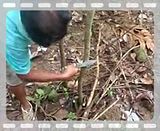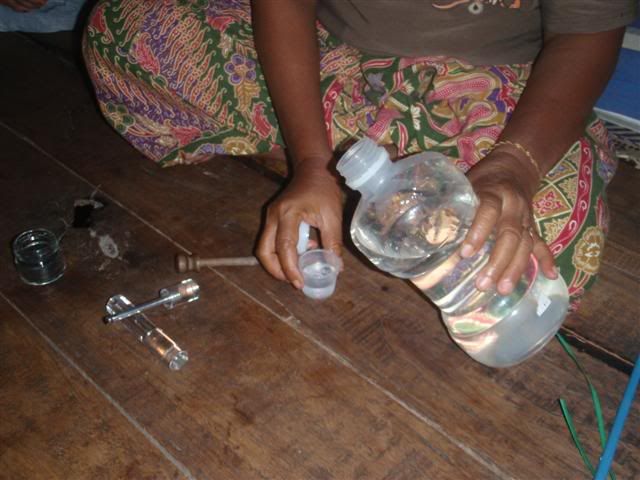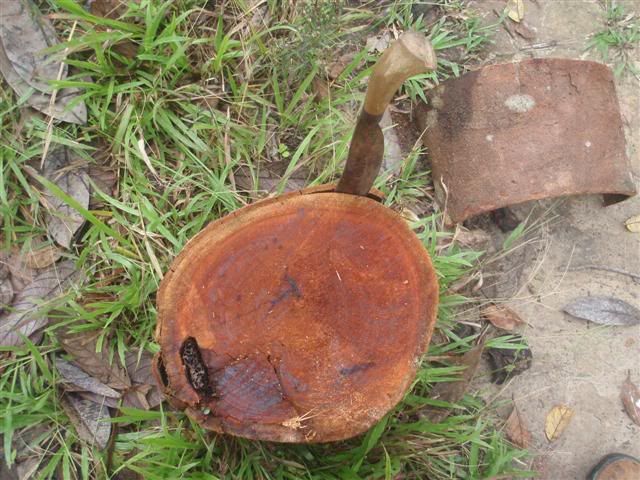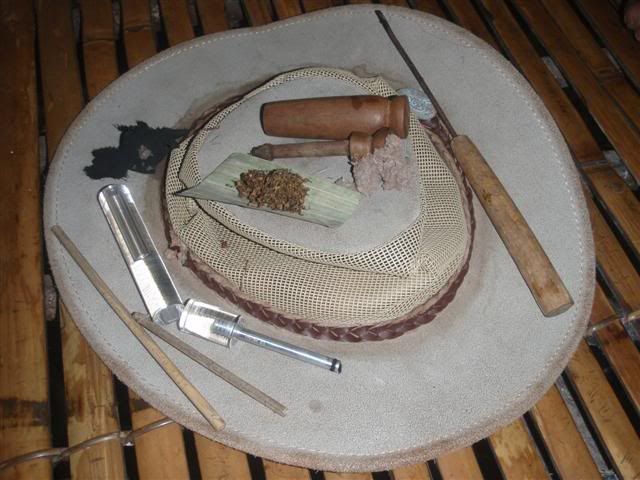UPDATED AFTER A MEETING WITH A NEW TRIBE
This is the modified text of an article I wrote for the Malaysian Naturalist. September Issue 2008 Since it is not likely to be easily available, and as our BCUK mag is not likely to be out for awhile I thought some people might be interested in it . It is also a way of thanking Tony and BCUK for all the knowledge, disputation, entertainment and fun over the years.
Galemys is effectively co-author as he proofed it, improved it, provided references and also steered me in my field work. He can't be blamed for anything but deserves at least half the credit. Darrell Aune (firemaker) and EdRead (Ed4sobrevivencia) are also to be thanked for providing photos of their work in the original article and for advice.
“Naik, naik” urges the voice from the gloom as my eyes adjust to the change from bright sun to shade, inviting me to climb into his hut near the edge of the jungle.
“I have been expecting you”, he tells me, “for the past three days”, testifying to the efficiency of the bush telegraph in this remote pristine rainforest in Malaysia where there is no phone service and communication is by radio .
“They said there was someone who was not asking the usual questions”, he smiles, extending his hand as I sit down on the floor of his 10 by 20 foot wood and bark hut. I join his wife and two little boys, one armed with a wooden toy gun that shoots pebbles.
Light comes through the small doorless entrance and a window, which perfectly frames the forest and the plateau of the Endau-Rompin watershed.
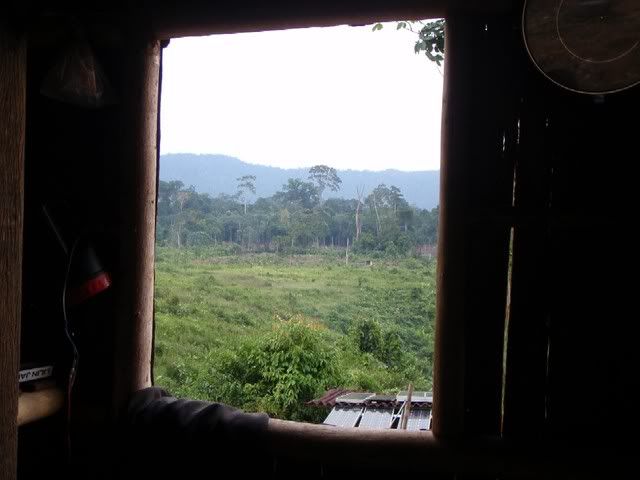
We make small talk and I enquire about his family. He tells me that he has been suffering from a hot and cold fever for a few days which is why he is in the hut and not in the kampong. His description of what seems like malaria makes me aware of the fragility of life here and my lack of insect repellent.
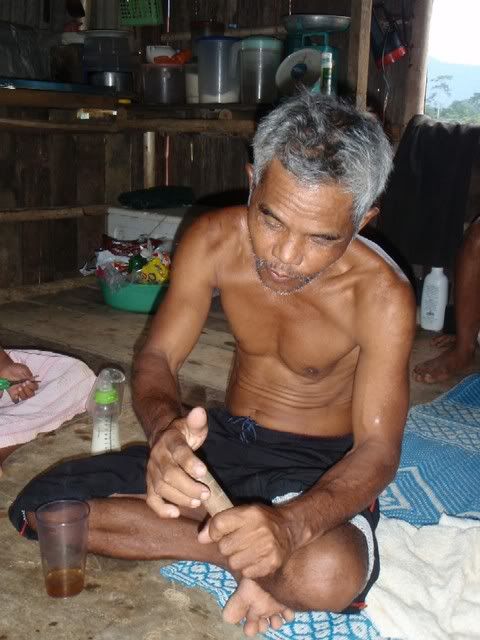
The proto Malay Jakun are the only known people who still use the fire piston and my visit is to document whatever knowledge remains of this unique and ingenious device. Most aboriginal people make fire by two basic methods: either by friction, rubbing two sticks together; or by percussion, striking stone on stone or stone on metal . All these methods depend on having particular rock or certain plants readily available. Lack of suitable wood, or rocks, means no fire.
The Jakun and some other peoples of South East Asia were far more sophisticated using precision engineering and a knowledge of the behaviour of gases, to produce fire by compression wherever or whenever they needed it .
Early accounts by European travellers barely conceal their amazement when the natives lit their hand rolled cigarettes with these “cigarette lighters”. Some even suggested that the device should be brought back to Europe
The fire piston operates on the same principle as the diesel engine. It is a hollow cylinder closed on one end, with a moveable piston/plunger that creates an airtight seal. There is a shallow depression at the end of the piston where combustible tinder is placed. When the piston is rammed into the cylinder, air is rapidly compressed to about 500 psi: the temperature rises to about 300 degrees C and the tinder ignites. The piston is pulled out swiftly and the now glowing tinder used to start a fire or light a cigarette.
While the fire piston has all but disappeared in aboriginal Asia, it has an enthusiastic following in the West among woodworkers, hobbyists, bush-crafters and pyrologists.
Modern fire pistons are made in workshops with electric powered tools using metal and acrylics as well as traditional wood and bone. The precision needed to make a device that can compress air at a 25:1 ratio requires great skill even using modern tools. Modern makers have long wondered how it was possible to do this, with only simple tools, in a rainforest . I was hoping that Ameng would be able to tell me.
“We use a hand spun drill”, he says, miming the action of a wooden spindle rubbed between his palms.
“But we don’t let it get too hot” he replies to my query.
“We dip the tip in water too cool it down”.
I am amazed. I thought he would describe a metal drill or auger and some kind of jig, or frame, to keep the drill shaft straight as is done in Borneo to make wooden blowpipes. An amateur fire maker myself, I know how difficult a hand spun tool would be to use and imagine the concentration and skill needed to bore a straight hole. That they use a wooden drill suggests that the technology is very old.
“It takes about two weeks”, he says. “The outside of the cylinder is the carved from a block of wood and a matching piston is made”. The favourite woods are tempenis (Streblus elongatus) and something called gombang which I do not recognise.
To make the piston airtight, fibre from the terap tree (Artocarpus elasticus), which is used for bark clothes traditionally, is wound around the end of the piston to make a gasket, or seal. To lubricate it a drop of fish oil is put on the fibre. Nowadays, jute fibre from gunny sacks is used.
The tinder is a mixture made of the sun-dried woolly scurf found between the layers of the tukas palm a.k.a. Burmese Fish Tail Palm (Caryota mitis) and the charred fibre of what remains of the manioc leaf when it has been scorched in a pan. This is similar to the Iban and Dusun method of tinder preparation in Borneo.
Ameng’s description of cylinder making also casts doubt on one theory of how the people of South East Asia discovered fire by compression. While making wooden blowpipes, the theory goes, dust accumulates in the incomplete bore and if the maker rams the drill up and down the barrel to clear it, the compression might sometimes ignite the dry dust .
The Jakun use wooden blowpipes but do not drill holes to make the barrel. Rather, they split the future blowpipe lengthwise and cut a matching groove in each half, which is then rejoined and tightly seized with rattan and glued with dammar (resin). The bore is then sanded smooth with rattan. The inspiration, for the Jakun at least, must have come from elsewhere.
Another theory suggests that the fire piston was introduced to Asia by Europeans . Certainly the fire syringe, a similar device made of metal, was patented in Europe in the early 1800’s. Earlier records mention dust igniting and flying sparks emerging when air guns were fired .
Still, this theory doesn’t explain why it was the most remote of forest dwellers who allegedly reverse-engineered the device making it out of wood. More probable candidates would be the metallurgicaly more advanced peoples in the region such as the Bruneian and Malaccan armourers, renowned for their cannons and muskets, or the Chinese trading communities. Another problem with this theory is that it fails to take into account the slow pace of dissemination of new technology into the remoter regions of the Malay archipelago. Fire pistons do not appear to have been trade goods shipped out in commercial quantities and indeed in Europe they were soon replaced as fire starters by the matchstick invented a few years after the fire syringe patent was registered . The device continued to be made -with glass or acrylic cylinders- as a scientific curiosity for demonstrations of the thermodynamics laws)
A third possibility is that it was introduced to South East Asia by early contact with South India. Artifacts have been discovered in Adichanalur that appear to be fire pistons dating from 1000 BC . But the Indian devices are made of metal like the European fire syringe and South East Asian ones are predominantly wood or bamboo. Indeed it is more likely that the technology was discovered separately.
in one case , it seems that the technology travelled in the opposite direction. In the 1870’s Carl von Linde, a physicist and head of the Thermodynamics laboratory of what later became the Technical University of Munich gave a talk in Penang while on a tour of the Far East. He was given a fire piston as a souvenir. On his return to Germany, he gave a “show and tell” to his students ending the talk by lighting a cigarette with his new fire piston. One of his assistants was Rudolf Diesel, the inventor of the diesel engine which was patented a number of years after the lecture .
It would seem then that it is not the fire piston that operates on the Diesel principle, but the diesel engine which operates on the Jakun principle!
Whatever the origin, the fire piston started to disappear in South East Asia by the early 1900s and there are few, if any, written accounts after that. Ameng tells me that the api lantak (fire piston) began disappearing as matches made their way to the Jakun. However, the perang Jepun (the WW2 Japanese war) led to its revival. War stopped trade and the Jakun headed for the hills to avoid the Japanese. The men still needed their cigarettes. Matches were scarce so they returned to the fire piston and a dependable and renewable technology was passed on to a further two generations in this remote community.
Elsewhere , in the South East Asian it had seemingly vanished and was almost unknown in the West, outside museums. Old technology does not die it just fades away.
Then in the 1970s, a US Navy helicopter landed in the Philippine jungle and its crew met a aborigines. Cigarettes were offered and accepted. To the surprise of the soldiers, the natives used a strange device to light the cigarettes. One of the soldiers, survival instructor Mel de Weese, traded a Zippo lighter and some chewing gum for a fire piston. de Weese later returned to the US but by then, not being the pilot, could not remember where he had obtained the piston. De Weese introduced the fire piston to a wider audience and so started the revival of this 'primitive' fire starting method in the West Other people began to make them and today beautifully turned fire pistons are made and sold on eBay and elsewhere . Eventually, pyrologists began to ask whether they were still used by traditional societies?
I had been collaborating with Tom Lourens, an expert on ancient fire making methods in the paleotropics*. Steered by his research, we had ‘found’ the traditional tinder for the Borneo fire piston while recording another fire making technique. So we thought that we would try and find the answer to that question. A chance meeting in Cameron Highlands with Francis Cheong, a Johore Parks manager led me to Endau Rompin where villagers directed me to Ameng and a couple of other men who showed me their pistons.
This one is old elephant ivory

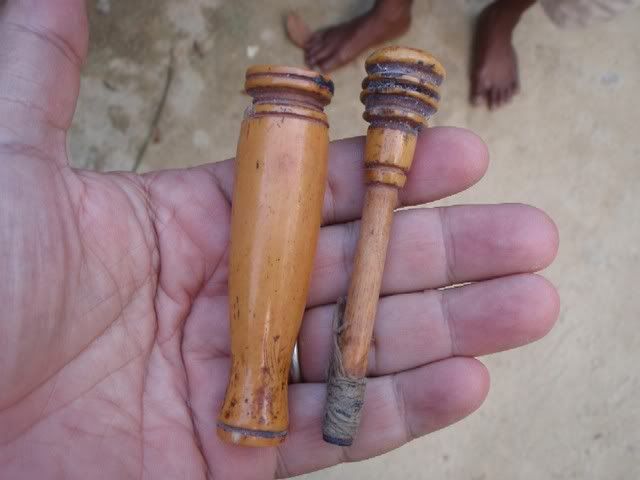
Wood

The joy of finding the device was marred by the realization that they are in danger of losing their technology. The skills needed to make a fire piston reside with a very small number of men. For the younger Jakun, the api lantak is an old peoples device and they are not overly interested in it. Even middle- aged men told me they had never made one. Most use lighters now.
When visitors come to the park their interest is in watching blow pipe demonstrations and trap making. The fire piston, like the intricate bamboo and string puzzles made by the Jakun is considered just a curiosity, a toy, rather than the products of highly sophisticated minds with an acute understanding of the properties of the natural world around them.
The issue is not that the Jakun have lost their intellectual property. Most indigenous peoples are pleased when told that their medical ethnobotanical knowledge, is used in modern societies. The Jakun are likely to be proud that their technology is incorporated in the engines of the industrial world and is still appreciated by craftsmen in its original application.
Credit has given by international scholars and historians . Museums elsewhere such as the Smithsonian, the Pitt Rivers, the British Museum and several European museums have permanent displays of fire pistons. The Musee de Paleontologie in France has just completed a year long exhibition of the art and science of fire making including fire pistons from Malaya and Borneo. But there are no displays evident in the museums in KL or Singapore. Three fire pistons are found in Jakarta.
Sadly, there is no recognition and understanding in their own country, or even among the Jakun themselves, of their achievements and heritage.
Those interested in the journey there can find it at http://www.bushcraftuk.com/forum/showthread.php?t=30531
This is the modified text of an article I wrote for the Malaysian Naturalist. September Issue 2008 Since it is not likely to be easily available, and as our BCUK mag is not likely to be out for awhile I thought some people might be interested in it . It is also a way of thanking Tony and BCUK for all the knowledge, disputation, entertainment and fun over the years.
Galemys is effectively co-author as he proofed it, improved it, provided references and also steered me in my field work. He can't be blamed for anything but deserves at least half the credit. Darrell Aune (firemaker) and EdRead (Ed4sobrevivencia) are also to be thanked for providing photos of their work in the original article and for advice.
“Naik, naik” urges the voice from the gloom as my eyes adjust to the change from bright sun to shade, inviting me to climb into his hut near the edge of the jungle.
“I have been expecting you”, he tells me, “for the past three days”, testifying to the efficiency of the bush telegraph in this remote pristine rainforest in Malaysia where there is no phone service and communication is by radio .
“They said there was someone who was not asking the usual questions”, he smiles, extending his hand as I sit down on the floor of his 10 by 20 foot wood and bark hut. I join his wife and two little boys, one armed with a wooden toy gun that shoots pebbles.
Light comes through the small doorless entrance and a window, which perfectly frames the forest and the plateau of the Endau-Rompin watershed.

We make small talk and I enquire about his family. He tells me that he has been suffering from a hot and cold fever for a few days which is why he is in the hut and not in the kampong. His description of what seems like malaria makes me aware of the fragility of life here and my lack of insect repellent.

The proto Malay Jakun are the only known people who still use the fire piston and my visit is to document whatever knowledge remains of this unique and ingenious device. Most aboriginal people make fire by two basic methods: either by friction, rubbing two sticks together; or by percussion, striking stone on stone or stone on metal . All these methods depend on having particular rock or certain plants readily available. Lack of suitable wood, or rocks, means no fire.
The Jakun and some other peoples of South East Asia were far more sophisticated using precision engineering and a knowledge of the behaviour of gases, to produce fire by compression wherever or whenever they needed it .
Early accounts by European travellers barely conceal their amazement when the natives lit their hand rolled cigarettes with these “cigarette lighters”. Some even suggested that the device should be brought back to Europe
The fire piston operates on the same principle as the diesel engine. It is a hollow cylinder closed on one end, with a moveable piston/plunger that creates an airtight seal. There is a shallow depression at the end of the piston where combustible tinder is placed. When the piston is rammed into the cylinder, air is rapidly compressed to about 500 psi: the temperature rises to about 300 degrees C and the tinder ignites. The piston is pulled out swiftly and the now glowing tinder used to start a fire or light a cigarette.
While the fire piston has all but disappeared in aboriginal Asia, it has an enthusiastic following in the West among woodworkers, hobbyists, bush-crafters and pyrologists.
Modern fire pistons are made in workshops with electric powered tools using metal and acrylics as well as traditional wood and bone. The precision needed to make a device that can compress air at a 25:1 ratio requires great skill even using modern tools. Modern makers have long wondered how it was possible to do this, with only simple tools, in a rainforest . I was hoping that Ameng would be able to tell me.
“We use a hand spun drill”, he says, miming the action of a wooden spindle rubbed between his palms.
“But we don’t let it get too hot” he replies to my query.
“We dip the tip in water too cool it down”.
I am amazed. I thought he would describe a metal drill or auger and some kind of jig, or frame, to keep the drill shaft straight as is done in Borneo to make wooden blowpipes. An amateur fire maker myself, I know how difficult a hand spun tool would be to use and imagine the concentration and skill needed to bore a straight hole. That they use a wooden drill suggests that the technology is very old.
“It takes about two weeks”, he says. “The outside of the cylinder is the carved from a block of wood and a matching piston is made”. The favourite woods are tempenis (Streblus elongatus) and something called gombang which I do not recognise.
To make the piston airtight, fibre from the terap tree (Artocarpus elasticus), which is used for bark clothes traditionally, is wound around the end of the piston to make a gasket, or seal. To lubricate it a drop of fish oil is put on the fibre. Nowadays, jute fibre from gunny sacks is used.
The tinder is a mixture made of the sun-dried woolly scurf found between the layers of the tukas palm a.k.a. Burmese Fish Tail Palm (Caryota mitis) and the charred fibre of what remains of the manioc leaf when it has been scorched in a pan. This is similar to the Iban and Dusun method of tinder preparation in Borneo.
Ameng’s description of cylinder making also casts doubt on one theory of how the people of South East Asia discovered fire by compression. While making wooden blowpipes, the theory goes, dust accumulates in the incomplete bore and if the maker rams the drill up and down the barrel to clear it, the compression might sometimes ignite the dry dust .
The Jakun use wooden blowpipes but do not drill holes to make the barrel. Rather, they split the future blowpipe lengthwise and cut a matching groove in each half, which is then rejoined and tightly seized with rattan and glued with dammar (resin). The bore is then sanded smooth with rattan. The inspiration, for the Jakun at least, must have come from elsewhere.
Another theory suggests that the fire piston was introduced to Asia by Europeans . Certainly the fire syringe, a similar device made of metal, was patented in Europe in the early 1800’s. Earlier records mention dust igniting and flying sparks emerging when air guns were fired .
Still, this theory doesn’t explain why it was the most remote of forest dwellers who allegedly reverse-engineered the device making it out of wood. More probable candidates would be the metallurgicaly more advanced peoples in the region such as the Bruneian and Malaccan armourers, renowned for their cannons and muskets, or the Chinese trading communities. Another problem with this theory is that it fails to take into account the slow pace of dissemination of new technology into the remoter regions of the Malay archipelago. Fire pistons do not appear to have been trade goods shipped out in commercial quantities and indeed in Europe they were soon replaced as fire starters by the matchstick invented a few years after the fire syringe patent was registered . The device continued to be made -with glass or acrylic cylinders- as a scientific curiosity for demonstrations of the thermodynamics laws)
A third possibility is that it was introduced to South East Asia by early contact with South India. Artifacts have been discovered in Adichanalur that appear to be fire pistons dating from 1000 BC . But the Indian devices are made of metal like the European fire syringe and South East Asian ones are predominantly wood or bamboo. Indeed it is more likely that the technology was discovered separately.
in one case , it seems that the technology travelled in the opposite direction. In the 1870’s Carl von Linde, a physicist and head of the Thermodynamics laboratory of what later became the Technical University of Munich gave a talk in Penang while on a tour of the Far East. He was given a fire piston as a souvenir. On his return to Germany, he gave a “show and tell” to his students ending the talk by lighting a cigarette with his new fire piston. One of his assistants was Rudolf Diesel, the inventor of the diesel engine which was patented a number of years after the lecture .
It would seem then that it is not the fire piston that operates on the Diesel principle, but the diesel engine which operates on the Jakun principle!
Whatever the origin, the fire piston started to disappear in South East Asia by the early 1900s and there are few, if any, written accounts after that. Ameng tells me that the api lantak (fire piston) began disappearing as matches made their way to the Jakun. However, the perang Jepun (the WW2 Japanese war) led to its revival. War stopped trade and the Jakun headed for the hills to avoid the Japanese. The men still needed their cigarettes. Matches were scarce so they returned to the fire piston and a dependable and renewable technology was passed on to a further two generations in this remote community.
Elsewhere , in the South East Asian it had seemingly vanished and was almost unknown in the West, outside museums. Old technology does not die it just fades away.
Then in the 1970s, a US Navy helicopter landed in the Philippine jungle and its crew met a aborigines. Cigarettes were offered and accepted. To the surprise of the soldiers, the natives used a strange device to light the cigarettes. One of the soldiers, survival instructor Mel de Weese, traded a Zippo lighter and some chewing gum for a fire piston. de Weese later returned to the US but by then, not being the pilot, could not remember where he had obtained the piston. De Weese introduced the fire piston to a wider audience and so started the revival of this 'primitive' fire starting method in the West Other people began to make them and today beautifully turned fire pistons are made and sold on eBay and elsewhere . Eventually, pyrologists began to ask whether they were still used by traditional societies?
I had been collaborating with Tom Lourens, an expert on ancient fire making methods in the paleotropics*. Steered by his research, we had ‘found’ the traditional tinder for the Borneo fire piston while recording another fire making technique. So we thought that we would try and find the answer to that question. A chance meeting in Cameron Highlands with Francis Cheong, a Johore Parks manager led me to Endau Rompin where villagers directed me to Ameng and a couple of other men who showed me their pistons.
This one is old elephant ivory


Wood

The joy of finding the device was marred by the realization that they are in danger of losing their technology. The skills needed to make a fire piston reside with a very small number of men. For the younger Jakun, the api lantak is an old peoples device and they are not overly interested in it. Even middle- aged men told me they had never made one. Most use lighters now.
When visitors come to the park their interest is in watching blow pipe demonstrations and trap making. The fire piston, like the intricate bamboo and string puzzles made by the Jakun is considered just a curiosity, a toy, rather than the products of highly sophisticated minds with an acute understanding of the properties of the natural world around them.
The issue is not that the Jakun have lost their intellectual property. Most indigenous peoples are pleased when told that their medical ethnobotanical knowledge, is used in modern societies. The Jakun are likely to be proud that their technology is incorporated in the engines of the industrial world and is still appreciated by craftsmen in its original application.
Credit has given by international scholars and historians . Museums elsewhere such as the Smithsonian, the Pitt Rivers, the British Museum and several European museums have permanent displays of fire pistons. The Musee de Paleontologie in France has just completed a year long exhibition of the art and science of fire making including fire pistons from Malaya and Borneo. But there are no displays evident in the museums in KL or Singapore. Three fire pistons are found in Jakarta.
Sadly, there is no recognition and understanding in their own country, or even among the Jakun themselves, of their achievements and heritage.
Those interested in the journey there can find it at http://www.bushcraftuk.com/forum/showthread.php?t=30531

